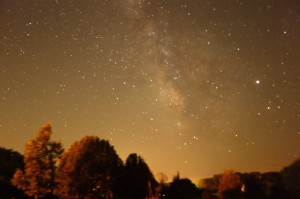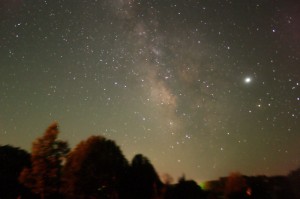Yesterday I spent the day at the MidAmerican Regional Astrophysics Conference. This year this roaming astronomy meeting was held just outside St Louis at St Charles Community College. I have to say I was really impressed with the quality of the presentations and the staff took care of me extraordinarily well. One of the ones that particularly caught my attention was on the use of didymium filters to minimize the effects of sodium light on astroimages. Here are some examples:
| Before | After |
 |
 |
In this presentation by Doug Kniffen, I learned that these photographic “enhancement” filters are fairly effective at blocking light the color emitted by sodium (and thus emitted in sodium lights). While not designed for telescopes, when employed for off label uses, these filters allow astroimagers to take aesthetically pleasing pictures from sites that otherwise can’t support deep sky photography.
If you look closely at the images above, you’ll notice there are actually more stars near the horizon in the After image than in the before. Specifically, look above and to the right of the house in the center. There are two stars in the image on the right that just aren’t in the image on the left.
From what Kniffen said, you can’t get these filters in standard – screw onto your eyepiece or insert into your filter wheel – sizes, but they do exist in many camera size, perfect for the piggy backed camera. I did a bit of research, and found them here at very reasonable prices (mind you, in grad school I managed to destroy a $1500 filter, so, well… I have weird scales for these things). Now that our house has roof top access (we are resurrecting a widows walk), I may have to get one and try doing some city-based astrophotography. It has been a long time since by happy little SLR (yes, film) camera saw starlight, and a new filter just might be the kick in the butt I need to get going again.



Pamela:
At $35.85 that’s -MUCH- cheaper than that $1,500 one that bought the dust!
From the site you linked to:
——————-
Hoya 55mm Intensifier Filter Overview
Also known as a ‘didymium’ filter, this is used to enhance red, orange and brown subjects to give more color saturation and contrast, whilst having very little effect on other colors. It can be used in many situations such as architecture where certain building features need emphasising, or for landscapes to enhance foliage and rocky features.
——————-
It’s weird that the yellow dual lines of sodium would be clipped out by this filter, but if Doug Kniffen says it does so (and your images show so) then that’s good enough for me! I’ve gotta check the filter thread sizes of my lenses…
You should really get a digital SLR. It’ll be money well spent. The Nikon D40 is going for 400-500 nowadays. Of course then you’d need a GEM… You wouldn’t have to get a Paramount :drool: when a smaller Orion mount would do.
You sure have had a good run of conferences in your own back yard! First it was ASP, now this! I hope you’re recording some bits for the podcast! A tiny digital audio recorder would fit the bill… More toys… Christmas is coming!
Rich in Charlottesville
Pamela,
Haven’t done film in a while but if you are going to dig out that SLR, Fuji Provia 400F and Kodak E200 slide film will still give pretty good results. All of the good print films for astrophotography are long gone.
Brian.
Pamela,
It was the annual convention of the Mid-States Region of the Astronomical League. It would be great if we were elevated to an Astrophysics conference but not yet. Just a bunch of dedicated amateurs.
Your talk was quite inspiring by the way.
jerry
For that price, I might give it a shot. I am using a Canon Digital Rebel XTi and am starting to get some nice night shots, unguided short exposures of satellites and constellations.
Pamela,
Jerry was correct, just a bunch of astronomy geeks. Your enthusiasm regarding public outreach is contageous. That is one reason I have gotten envolved in Urban Guerilla Astronomy – actually Sidewalk Astronomers was already taken.
I am looking forward to all planned activities for IYA. Thank you very much for coming out and speaking to our collegues, it was like a breath of fresh air.
Cook
Hi All:
Check out Amazon for the filter. My Digital Rebel XTi uses a 58mm filter. I found it for $20 less than the referenced site.
Clear skies.